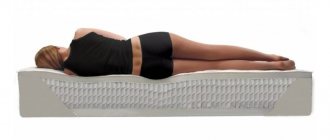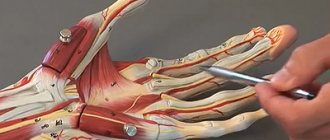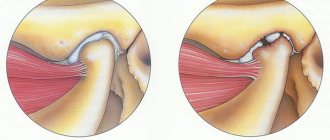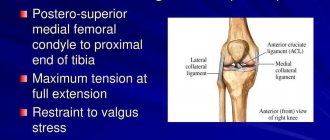Dizziness is a very common problem among people of all ages. And although such health complaints are most often made by representatives of the older age group, even teenagers and children are not immune from their occurrence. In this case, the main cause of dizziness is osteochondrosis, the first signs of which are found in many people after 30 years.
The vestibular system and the main features of its functioning
The vestibular system is responsible for maintaining body balance when performing all movements, both voluntary and involuntary, as well as when changing body position or posture. This is achieved due to its close relationship with other parts of the nervous system, in particular the visual, cerebellar, proprioceptive, extrapyramidal, cortical and spinal.
When the body is faced with the need to maintain balance, the nerve impulse initially originates in the peripheral receptors of the semicircular canals of the labyrinth, which are part of the inner ear. From them, through the vestibular nuclei of the brain stem, they are transmitted to other systems and turn on complex mechanisms for maintaining balance at each individual moment in time when performing a particular movement. This ensures maintaining balance when running, walking, bending, changing direction and speed, etc.
Of great importance in this mechanism is the transmission of nerve impulses from the lateral vestibular nuclei to the motor ones located in the spinal cord. This is realized through the vestibulospinal and reticulospinal tracts, as they are responsible for the degree of tonic tension of skeletal muscles. They trigger a mechanism for reducing the tone of some muscle groups, while simultaneously increasing the tone of others in accordance with the characteristics of changes in body position. This is called reciprocity or reciprocal innervation. This ensures stability and balance.
The mechanism of development of dizziness in osteochondrosis
One of the systems directly involved in the normal course of this complex process is the proprioceptive sensitivity system. The largest flow of nerve impulses to the lateral vestibular nuclei comes from receptors located in various anatomical structures of the neck (joints, muscles, bone-ligamentous structures). Movements in the altered discs and joints of the cervical vertebrae lead to an increase in the flow and inadequacy of incoming signals, and therefore the vestibular system incorrectly assesses the position of the head. Therefore, with osteochondrosis and often accompanying spondylosis, there is a violation of control over reciprocal muscle tone, which leads to deterioration in coordination of movements, unsteadiness of gait, even falls, and dizziness.
Osteochondrosis is a disease in which degenerative changes occur in the intervertebral discs separating the bodies of adjacent vertebrae. This leads to a decrease in their resistance to loads, a decrease in height and creates the prerequisites for compression of the anatomical structures passing through the spine: spinal roots, blood vessels, etc.
This is explained by the development of transient ischemia (insufficient blood supply) of the labyrinth due to pinching of the cervical vertebral arteries passing through the vertebrae or the periarterial sympathetic nerve plexus. This also leads to the development of impaired blood supply to certain parts of the brain, which is called vertebrobasilar insufficiency.
The mechanical loads that the cervical spine experiences daily lead not only to the development of osteochondrosis, i.e., pathological changes in the intervertebral discs, but also to reactive changes on the part of the adjacent vertebral bodies. As a result, osteophytes (bone protrusions) are formed on different parts of their surface, which grow in different directions. This is called spondylosis.
Osteophytes can form on the anterior and posterior surfaces of the vertebral bodies, and can also be directed into the spinal canal or into the bone canal of the transverse processes of the cervical vertebrae, in which the vertebral arteries pass. The walls of these important blood vessels, which unite in the occipital region to form the basilar artery and form the vertebrobasilar basin, are easily damaged. They can be mechanically compressed by osteophytes or converging articular processes due to unsuccessful neck movements and manipulations. This leads to a decrease in their lumen in a specific area, which entails a decrease in the intensity of blood supply to the brainstem-cerebellar structures located in the brain. In such cases, vertebral artery syndrome is diagnosed.
Also, compression of the vertebral artery can occur against the background of a reflex muscle spasm, which is the body’s response to pain caused by pathological changes in the intervertebral discs and other vertebral structures.
Also, osteophytes can easily pinch and even injure the spinal roots passing in the spinal canal, i.e., near the posterior surface of the vertebral bodies. This leads to neck pain, headaches, neurological disorders, manifested by sensory disturbances and limited movement of different parts of the arms, for the innervation of which the pinched nerve is responsible.
If osteophytes are present in the bone canal of the processes of the cervical vertebrae or a lateral intervertebral hernia is formed against the background of osteochondrosis, they can irritate the nerves of the periarterial sympathetic plexus, which entwines the vertebral artery. It is also called Frank's nerve. This can also provoke the development of dizziness as a result of spasm of the walls of one or both vertebral arteries. This leads to a decrease in the volume of blood flow in it by 30% of the initial value and also provokes circulatory disorders in the vertebrobasilar area.
How to get rid of dizziness
Hemodynamic disorders that occur in the brain with cervical osteochondrosis can be treated using folk remedies, medications, and special exercises.
Drugs for dizziness in cervical osteochondrosis act in two directions. Some medications improve blood circulation in the cerebral arteries, while others act on the cause of spinal diseases that lead to vascular compression.
First, doctors prescribe medications to relieve pain, which can be in the form of injections or tablets. Anti-inflammatory injections, as a rule, are given no longer than 7 days, but the duration of treatment still depends on the patient’s individual criteria.
Tablets for dizziness in cervical osteochondrosis include non-steroidal anti-inflammatory drugs - Diclofenac, Celecoxib, Indomethacin; drugs affecting vascular tone - Troxerutin, Diosmin, Ginko-biloba, Nimodipine and blood microcirculation - Pentoxifylline, Trental, Vinpocetine, Sermion.
Neuroprotective therapy is also used - drugs that relieve the effects of brain damage due to incoming episodes of ischemia. Improve energy processes in brain tissue - Cytocolin, Gliatilin, Mildronate, activate regeneration Actovegin, Thiotriazolin, Trimetazidine. Nootropic drugs - Picamilon, Aminalon, Cinnarizine, Phenibut - also help eliminate dizziness. To nourish cartilage tissue, drugs with chondroitin and glucosamine, collagen, as well as complex vitamins B, C, D - Milgamma, Neurobeks, Vitaxon are prescribed.
[node:field_similarlink]
Non-drug treatment
In addition to regularly taking medications, patients with dizziness due to osteochondrosis must be prescribed a diet (avoiding smoked foods, pickles, alcohol, coffee, chocolate, fatty foods), physiotherapy, massage and a set of exercises.
Gymnastics for the neck helps reduce the load on its muscles, relieve spasms, as well as improve blood supply to the vertebrae and slow down degenerative processes.
For cervical osteochondrosis, it is necessary to perform a complex of exercise therapy during the day.
To improve well-being, therapeutic exercises are performed slowly, with great care to avoid pain:
- Sitting on a chair, keep your back straight and look forward. Turn your head with gentle movements left and right, fixing the extreme position for a few seconds. Repeat the exercise 10–20 times;
- Without changing your position, tilt your head left and right. Avoid cramps and pain by gradually stretching your joints and muscles. As in the first exercise, fix the extreme position;
- press your chin as close as possible to your chest, feel the stretch in your cervical spine, and turn your head left and right in this position. This is a diagonal stretch of the back muscles of the neck.
During the period of exacerbation of chondrosis and increased frequency of attacks of dizziness, it is recommended to use a special support collar, which limits movement in the cervical region.
The effect of manual therapy for osteochondrosis
Traditional methods of treatment recommend using infusions and decoctions of medicinal herbs, which have anti-inflammatory and analgesic effects, and also reduce swelling. Herbs help remove the unpleasant manifestations of cervical osteochondrosis, improve blood circulation, relieve spasms and normalize the autonomic nervous system. They must be taken regularly to achieve the desired effect.
For medicinal purposes they use:
- infusion of celery root - a tablespoon three times a day;
- tincture of barberry berries – 30 drops, 3 times a day;
- propolis tincture mixed with aloe leaves and mustard powder in the form of a compress at night;
- a compress made of canvas soaked in kerosene - for the night;
- pain-relieving lotions made from grated potatoes or lemon and garlic;
- cervical massage with honey.
No ads 2
There are also recommendations to help you understand what not to do if you are prone to dizziness.
- Engage in sports that require lifting weights or the body experiences prolonged static vertical load
- “Crunch” your neck. Such a warm-up provokes rapid destruction of the cervical vertebrae and pinching of blood vessels and nerves.
- Sleep with a high pillow on a very soft bed. This contributes to deformation of all parts of the spine.
- Wearing uncomfortable shoes that shifts the center of gravity and forces the head to move out from its normal axis, overstraining the neck muscles.
- Abuse foods that retain water in the body - coffee, alcohol, salt, marinades.
Types of stress that provoke exacerbation of osteochondrosis and dizziness
Important! Self-medication of dizziness is unacceptable, since this symptom can occur not only with osteochondrosis. Dangerous sources of discomfort can be: disorders in the inner ear, its inflammation (labyrinitis), cardiovascular hypotension, neuronitis, damage to the brain stem, neurological diseases - migraine, epilepsy.
Features of the manifestation of dizziness in osteochondrosis
Patients may describe their condition during dizziness in different ways. If its cause lies in osteochondrosis, the person will experience a sensation of apparent movement, rotation of objects around him. This may be accompanied by a lack of coordination of movement, which is also called ataxia, and nystagmus is also often present, i.e. involuntary oscillatory movements of the eyeballs.
With osteochondrosis, there is a violation of automatic and conscious spatial orientation. Clinically, this is manifested by the appearance of a false sensation of movement of one’s body or objects in the environment, their circular rotation or partial movement, a feeling of a push to the side. If the periarterial sympathetic nerve plexus is pinched, attacks of dizziness occur when turning or tilting the head, which is accompanied by headaches and visual disturbances. This set of symptoms is called posterior cervical sympathetic syndrome.
It is important to differentiate dizziness caused by osteochondrosis from the so-called benign positional vertigo (BPV). In the latter case, severe dizziness also occurs when bending, throwing back and other movements of the head and neck, but, unlike manifestations of irritation of the periarterial sympathetic nerve plexus by osteophytes, the attacks are short-lived and disappear when the head returns to its normal position.
If osteochondrosis and spondylosis developing against its background lead to infringement of the vertebral arteries themselves, attacks of dizziness are complemented by other symptoms indicating ischemia of brain structures:
- diplopia or double vision;
- dysarthria or speech disorders;
- cerebellar disorders, including disorders of coordination, gait, etc.
Also, dizziness caused by osteochondrosis may be accompanied by the occurrence of neurological disorders due to compression of the spinal roots:
- pain in the cervical-occipital region and shoulder girdle, including shooting pain;
- pain in the hands;
- numbness in the hands and fingers, as well as other types of sensory disturbances in the hands, including decreased sensitivity to temperature stimuli.
This is usually observed after a long stay in a forced position with the head bent forward or after sleeping in an uncomfortable position or on a high pillow. Pain, especially severe pain, provokes a reflex spasm of the neck muscles. This leads to the development of limitation of its mobility in one or several directions. Therefore, in patients with cervical osteochondrosis, one can often notice a tendency to turn around, for example, when called, with the whole body, instead of limiting oneself to turning the head.
Thus, the distinctive features of dizziness caused by degenerative-dystrophic changes in the intervertebral discs or osteochondrosis are the presence of the following symptoms:
- acute onset of attack;
- feeling of a push to the side when turning the head;
- imbalance with a high risk of falling;
- neck pain, headaches and radiating to one or both arms;
- restrictions on neck and head mobility;
- sensitivity disorders.
One of the first manifestations of osteochondrosis is pain, which can be a consequence of irritation of the receptors of the intervertebral discs, ligaments, and muscles. Therefore, if it is present and attacks of dizziness occur regularly, you should contact a neurologist or vertebrologist.
Diagnostics
Patients who complain of dizziness are required to undergo a diagnosis of the condition of the cervical spine and blood vessels. But initially, the doctor will collect a complete history and find out what symptoms still bother the patient, the conditions for the onset of dizziness, the duration and severity of the attacks, etc. After this, an examination is carried out, during which the doctor will determine the presence or absence of nystagmus, and will conduct tests to determine the degree of stability of the patient , unsteadiness of gait, ability to maintain balance, etc. Patients will also be asked to undergo a series of neurological tests to assess the nature of neurological disorders or confirm their absence.
The data obtained allows us to assume the presence of vertebrogenic, i.e., associated with pathologies of the spine, dizziness and determine the degree of existing disorders. To confirm the diagnosis, identify the stage of osteochondrosis, the level of damage, and assess the quality of blood flow in the vertebrobasilar system, instrumental research methods are prescribed:
- X-ray of the cervical spine;
- CT;
- MRI;
- Ultrasound of the vessels of the neck and head.
The most informative diagnostic methods from the point of view of diagnosing degenerative changes in intervertebral discs is magnetic resonance imaging or MRI. It allows you to detect the slightest deviations from the norm and, in most cases, determine what exactly caused the dizziness, and therefore select the optimal treatment tactics.
Necessary research
Subjective symptoms of dizziness from osteochondrosis must be confirmed by the results of an objective study:
- radiography;
- CT scan;
- MRI;
- ultrasound doppler;
- angiography using functional tests for flexion-extension and neck rotation.
Ultrasound and Doppler examination of the neck vessels help identify the cause and areas of their compression
Treatment of cervical osteochondrosis
Patients are shown treatment aimed at eliminating pain, neurological disorders, normalizing muscle tone, improving blood circulation and stopping the progression of degenerative changes in the intervertebral discs. To be as effective as possible, it must be comprehensive.
In the acute period, patients are advised to rest. If necessary, wearing an orthopedic bandage – Shants collar – is prescribed.
Treatment tactics are selected individually for each patient depending on the degree of osteochondrosis, the presence of vertebral artery syndrome, neurological deficit and other disorders. There is no single, universal treatment regimen, since the doctor needs to take into account many disparate factors, in particular the presence of other concomitant diseases, the patient’s age, etc.
As a rule, patients are prescribed:
- drug therapy;
- physiotherapy;
- exercise therapy;
- manual therapy.
Also, patients diagnosed with osteochondrosis or spondylosis are advised to increase the level of physical activity, this is especially true for representatives of “sedentary” professions and people in general leading a sedentary lifestyle. So, if you need to do work while sitting in a forced position, it is recommended to take breaks every hour for active warm-up.
Drug therapy
Drug therapy for osteochondrosis and related disorders is aimed at improving well-being and eliminating existing pathological changes. Therefore, it is complex in nature and may include individually selected drugs from the following groups:
- NSAIDs are drugs with analgesic and anti-inflammatory properties, available in a variety of dosage forms. With their help, you can relieve pain of mild and moderate intensity, as well as reduce the inflammatory process. But when choosing forms for oral use (tablets, capsules), you need to be careful, since most drugs in this group have a negative effect on the functioning of the gastrointestinal tract and can provoke an exacerbation of peptic ulcers and gastritis. In most cases, NSAIDs are prescribed in short courses and then used on demand, that is, when pain occurs.
- Corticosteroids are medications prescribed to patients with advanced inflammatory processes that cannot be eliminated with NSAIDs. These drugs are prescribed only in short courses. They are also used to relieve severe pain when performing cervical spine blocks.
- Muscle relaxants are drugs used in the presence of severe muscle spasms. Thanks to them, it is also possible to reduce pain.
- Chondroprotectors are medications used to activate the regeneration processes of intervertebral discs. Most of them contain substances normally used by organisms to restore cartilage tissue, and therefore are completely safe. They are prescribed in long courses, lasting at least several months.
- B vitamins are drugs prescribed to improve nerve conduction, which is important in the presence of neurological disorders.
- Vascular drugs are drugs selected depending on the nature of the existing pathological changes. They improve the quality of blood circulation and thereby reduce the likelihood of dizziness, as well as dangerous complications of vertebral artery syndrome.
- Nootropics are drugs prescribed to improve brain function and prevent changes in it.
To relieve attacks of dizziness in osteochondrosis, as well as reduce the manifestations of balance disorders, patients can be prescribed betahistine hydrochloride (Betaserc). This drug is classified as a vestibulolytic drug. It helps improve blood supply to the structures of the inner ear, including the labyrinth, activates blood flow in the vertebrobasilar region and improves the condition of the vestibular structures of the brainstem and cerebellum. At the same time, he has proven himself exclusively on the positive side. It has no toxic effect on the body, is not addictive and effectively eliminates dizziness. Depending on the specifics of the situation, Betaserc can also be prescribed in long courses of 2-3 months in order to stop the progression of the pathological process.
Physiotherapy
For osteochondrosis, physiotherapeutic procedures are often prescribed to increase the effectiveness of other treatment methods. They help relieve inflammation, reduce pain, activate blood flow and normalize muscle tone. In most cases, they resort to help:
- electrophoresis;
- ultrasound therapy;
- magnetic therapy;
- laser therapy;
- diadynamic currents.
Depending on the severity of the situation, patients are prescribed a course of 7-15 procedures performed at certain intervals.
Exercise therapy
Regular, daily physical therapy exercises are recommended for all patients diagnosed with osteochondrosis. They allow:
- strengthen the muscles of the neck and shoulder girdle, which will reduce the load on the intervertebral discs and help stop the further progression of osteochondrosis;
- eliminate muscle spasms, thereby reducing pain, as well as the risk of compression of the vertebral artery by overly toned muscle;
- activate blood circulation, which will not only have a positive effect on the functioning of the entire vestibular system, but will also help to activate the nutrition of the intervertebral discs, which will also prevent the worsening of osteochondrosis.
But the training program must be compiled strictly individually, taking into account the changes detected using instrumental diagnostic methods. Otherwise, exercise can provoke not only a deterioration in well-being, the appearance of new attacks of dizziness, but also the progression of existing disorders. Therefore, the exercise therapy program should be drawn up by a specialist who has the results of the patient’s examination.
It is recommended to conduct the first classes under the supervision of a physical therapy instructor. This is required so that the patient can master the correct technique for performing each exercise shown to him, which will increase their effectiveness.
To obtain a therapeutic effect, it is important that exercise therapy be carried out systematically. Therefore, it is necessary to make time for them in your daily routine. In this case, the exercises should in no case be accompanied by sudden movements, as this can lead to compression of the vertebral artery, compression of the nerve and the development of an attack of acute dizziness, including loss of consciousness. Also, such carelessness can provoke a sharp increase in pain and a general deterioration of the condition. Therefore, it is necessary to engage in physical therapy in a calm, comfortable environment, without haste, making all movements confidently but smoothly.
In case of osteochondrosis, swimming has a very positive effect on the condition of the intervertebral discs, since this type of physical activity has a positive effect on the functioning of the whole body, but is not associated with an increased load on the cervical vertebrae. Therefore, almost all patients are recommended to visit the pool.
Manual therapy
In the treatment of osteochondrosis, one of the most effective methods is manual therapy. Thanks to her, she manages to:
- increase the distance between the vertebral bodies, thereby reducing the load on the intervertebral discs and preventing their further degeneration;
- eliminate compression of nerves;
- normalize muscle tone;
- eliminate pressure on the vertebral arteries, which will improve blood flow;
- eliminate pain, neurological disorders, attacks of dizziness;
- increase neck mobility.
However, working with the cervical spine requires a high level of qualification from a specialist. Indeed, unlike therapeutic massage, manual therapy involves deep work not only of muscles, but also of ligaments, as well as a direct effect on the vertebrae. Considering the relative fragility of the cervical spine, work with it should be carried out carefully and with a deep understanding of the techniques and features of the impact. Otherwise, there is a risk of worsening the condition and developing complications. At the Institute of Human Restoration, manual therapy is carried out by the best specialists who thoroughly understand the intricacies of working with the cervical spine and know the most effective methods for treating osteochondrosis in Moscow.
You can begin manual therapy only after the acute inflammatory process has stopped. Patients are prescribed a course of procedures, the number and frequency of which is determined individually. As a rule, patients notice significant positive changes after the first session. But it is important not to interrupt treatment and complete the entire course to the end. This will allow you to get the most pronounced, and most importantly, lasting result.
Thus, dizziness with osteochondrosis is not uncommon. It can occur as a result of the development of a variety of pathological changes caused by degenerative processes in the intervertebral discs, which affects the nature of the attacks and also determines the characteristics of the accompanying symptoms. But in any case, the appearance of dizziness should be considered as a reason for promptly contacting a neurologist. Otherwise, there is a risk of complications, including stroke as a result of acute cerebrovascular accident. Specialists from the Institute of Human Restoration are always ready to help, conduct comprehensive diagnostics and treatment of osteochondrosis and related pathologies.
0 0 votes
Article rating
Reviews
Elena I began to experience dizziness after I had a neck injury. After examination, it turned out that the intervertebral discs were damaged and osteochondrosis developed. Its consequences are manifested by mild dizziness, chills, and palpitations. Symptoms worsen when tilting the head. Therapy now consists of vascular drugs - Cavinton, magnesia, Lucetam, painkillers - injections of Movalis and Mydocalm, as well as electrophoresis for cervical calving.
Nikita I have a sedentary office job, so often even just climbing the stairs made me dizzy. It turned out that the reason was cervical osteochondrosis. Now, on the recommendation of a doctor, I regularly perform special neck exercises throughout the day, which unblock the blood vessels and tone the muscles. Thanks to them, the headaches are much less frequent and the unpleasant episodes when everything floats before your eyes have practically stopped.
Olga I was given a variety of diagnoses - both vegetative-vascular dystonia and migraine, but as a result it turned out that the cause of headaches and dizziness was osteochondrosis in the cervical hotel. Now I regularly undergo treatment with a chiropractor and do physical therapy exercises at home. My health has improved significantly, there is no staggering or terrible headaches, I can easily do without painkillers and not be afraid of sudden loss of consciousness.










